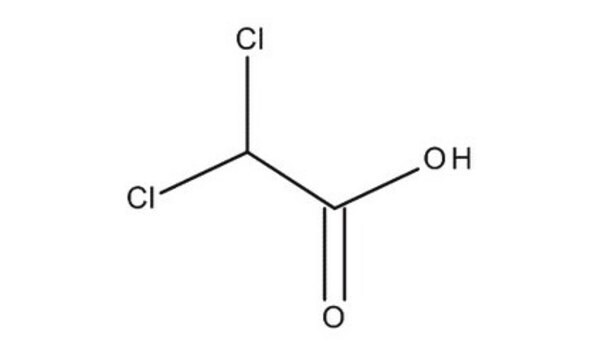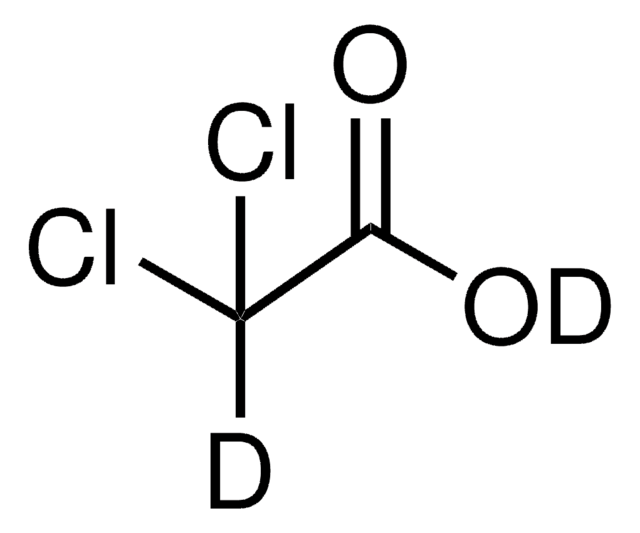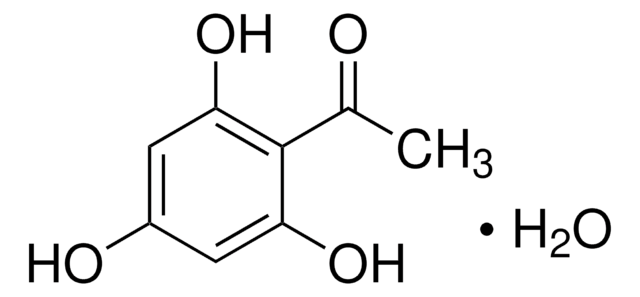D54702
Dichloroacetic acid
ReagentPlus®, ≥99%
Synonyme(s) :
2,2-Dichloroacetic acid, DCA, DCAA
About This Item
Produits recommandés
Densité de vapeur
4.5 (vs air)
Niveau de qualité
Pression de vapeur
0.19 mmHg ( 20 °C)
Gamme de produits
ReagentPlus®
Pureté
≥99%
Forme
liquid
Indice de réfraction
n20/D 1.466 (lit.)
Point d'ébullition
194 °C (lit.)
Pf
9-11 °C (lit.)
Densité
1.563 g/mL at 25 °C (lit.)
Groupe fonctionnel
carboxylic acid
chloro
Température de stockage
2-8°C
Chaîne SMILES
OC(=O)C(Cl)Cl
InChI
1S/C2H2Cl2O2/c3-1(4)2(5)6/h1H,(H,5,6)
Clé InChI
JXTHNDFMNIQAHM-UHFFFAOYSA-N
Informations sur le gène
human ... ALDH1A1(216) , PDK1(5163)
rat ... Pdk1(116551)
Vous recherchez des produits similaires ? Visite Guide de comparaison des produits
Catégories apparentées
Description générale
Application
- A reactant in the synthesis of chloroketones by reacting with esters in the presence of LiHMDS via Claisen-type homologation reaction.
- A structure-directing agent, solvent, or plastdopant for the preparation of different morphologies of polyaniline (PANI). Self-assembling nanostructured PANI may be formed due to the presence of strong hydrogen bonding between DCA and aniline/polyaniline.
Informations légales
Mention d'avertissement
Danger
Mentions de danger
Classification des risques
Acute Tox. 3 Dermal - Aquatic Acute 1 - Carc. 2 - Eye Dam. 1 - Lact. - Met. Corr. 1 - Repr. 1B - Skin Corr. 1A - STOT RE 2 Oral
Organes cibles
Brain,Liver,Testes
Risques supp
Code de la classe de stockage
6.1C - Combustible acute toxic Cat.3 / toxic compounds or compounds which causing chronic effects
Classe de danger pour l'eau (WGK)
WGK 3
Point d'éclair (°F)
235.4 °F - closed cup
Point d'éclair (°C)
113 °C - closed cup
Équipement de protection individuelle
Faceshields, Gloves, Goggles, type ABEK (EN14387) respirator filter
Faites votre choix parmi les versions les plus récentes :
Déjà en possession de ce produit ?
Retrouvez la documentation relative aux produits que vous avez récemment achetés dans la Bibliothèque de documents.
Articles
We presents an article about the Warburg effect, and how it is the enhanced conversion of glucose to lactate observed in tumor cells, even in the presence of normal levels of oxygen. Otto Heinrich Warburg demonstrated in 1924 that cancer cells show an increased dependence on glycolysis to meet their energy needs, regardless of whether they were well-oxygenated or not.
Notre équipe de scientifiques dispose d'une expérience dans tous les secteurs de la recherche, notamment en sciences de la vie, science des matériaux, synthèse chimique, chromatographie, analyse et dans de nombreux autres domaines..
Contacter notre Service technique











